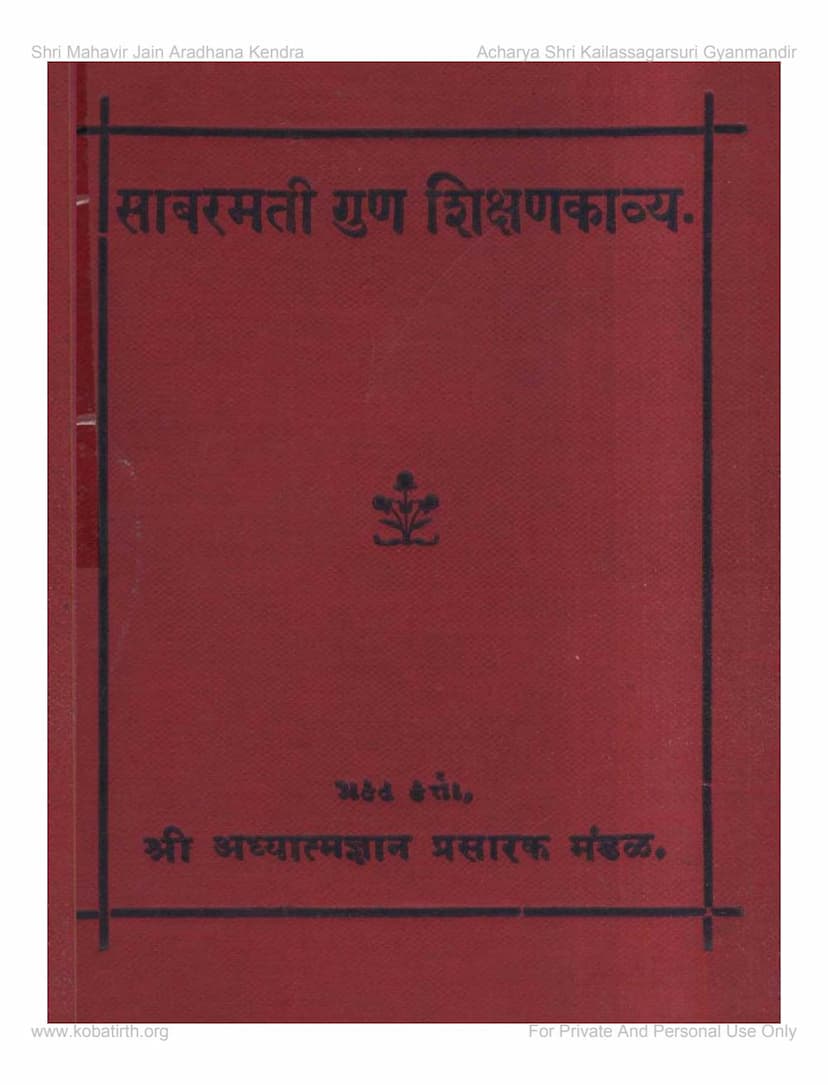Sabarmati Gun Shikshan Kavya
Added to library: September 2, 2025

Summary
Here's a comprehensive summary of the Jain text "Sabarmati Gun Shikshan Kavya" by Buddhisagar, based on the provided pages:
Book Title: Sabarmati Gun Shikshan Kavya (Sabarmati Virtuous Education Poem) Author: Acharya Shrimad Buddhisagar Surishwarji Publisher: Shri Adhyatma Gyan Prasarak Mandal Catalog Link: https://jainqq.org/explore/008644/1
Overview:
"Sabarmati Gun Shikshan Kavya" is a significant Jain text composed by Acharya Shrimad Buddhisagar Surishwarji. The work uses the Sabarmati River as a central metaphor and source of inspiration to impart moral, ethical, and spiritual lessons to its readers. The kavya (poem) aims to guide individuals towards self-improvement, virtuous living, and ultimately, the attainment of spiritual liberation (moksha) by drawing parallels between the natural flow and characteristics of the Sabarmati River and the path of spiritual discipline.
Key Themes and Content:
The text is rich with philosophical and practical teachings, presented in poetic form. The central theme revolves around observing the Sabarmati River and extracting profound lessons from its various aspects, behaviors, and interactions with its environment.
- The Sabarmati as a Teacher: The river serves as a living allegory for virtuous conduct and spiritual progress. Its constant flow, its ability to nourish life, its journey towards the vast ocean, and its response to changing seasons and environments are all used to illustrate key Jain principles.
- Virtue and Education (Gun Shikshan): The primary purpose of the work is to educate readers about virtues (guna). Through the poetic descriptions, the author aims to inspire readers to cultivate positive qualities like perseverance, detachment, selfless service, equanimity, and spiritual absorption.
- Spiritual Union (Tadmayata): A significant spiritual concept highlighted is the idea of becoming one with the divine (Paramatma). The Sabarmati's merging with the ocean is used as a metaphor for the soul's ultimate union with the Supreme Soul, achieved by shedding worldly attachments and realizing one's true nature.
- Nature as a Source of Wisdom: The text emphasizes the profound spiritual insights that can be gained by observing and reflecting upon nature. The Sabarmati, with its surrounding flora, fauna, and landscape, becomes a grand classroom for spiritual learning.
- Moral and Ethical Guidance: The kavya offers practical guidance on ethical living, covering topics such as:
- The importance of righteous conduct and the pursuit of truth.
- The consequences of negative actions and the cultivation of positive qualities.
- The value of selfless service (parmartha) and contributing to the well-being of others.
- The understanding of impermanence and the acceptance of life's dualities (chadhata and padata - rise and fall).
- The concept of equanimity and maintaining inner peace amidst external challenges.
- Literary Style and Composition: The work is written in a poetic style that incorporates various meters and forms, including Mandakranta, Harigiti, and Chopai. The language is accessible and designed to resonate with the heart and mind of the reader. The introduction notes that the poem evolved organically from the author's observations and reflections, often inspired by the river's presence.
- Inspiration for Self-Improvement: The core message is to encourage self-reflection and personal transformation. Readers are urged to imbibe the lessons learned from the Sabarmati and integrate them into their own lives to achieve spiritual growth and fulfillment.
- Universality of Teachings: The text highlights that the teachings are not limited to any particular religious sect, making them universally applicable to all who seek a virtuous and meaningful life.
Context and Purpose (as per the "Nivedan" - Foreword):
The foreword by the publisher (Shri Adhyatma Gyan Prasarak Mandal) explains the genesis and purpose of the work. It states that great souls, whether in wilderness or civilization, always act for the upliftment of all beings. This book, like similar works, aims to inspire readers to recognize virtues in all circumstances and to cultivate them within themselves. The author, Shrimad Buddhisagar Surishwarji, was motivated by the desire to impart these profound lessons, drawing inspiration from the Sabarmati River's essence. The foreword also mentions a preface written by Ra. Bholanath, son of Harjivandas Sharma, acknowledging the author's intention to provide a deeper understanding of the work.
Compilation and Structure:
The text appears to be a collection of observations and teachings inspired by the Sabarmati River, compiled into poetic verses. The author emphasizes the importance of observing the flow and nature of the river to glean profound spiritual truths. The work is extensive, with verses numbered sequentially, covering a wide array of philosophical and ethical topics derived from the river's analogy.
Overall Significance:
"Sabarmati Gun Shikshan Kavya" is a valuable contribution to Jain literature, offering a unique blend of poetic beauty, philosophical depth, and practical spiritual guidance. It serves as a testament to the author's wisdom and his ability to find profound spiritual lessons in the mundane, natural world, urging readers to cultivate virtues and strive for spiritual perfection.